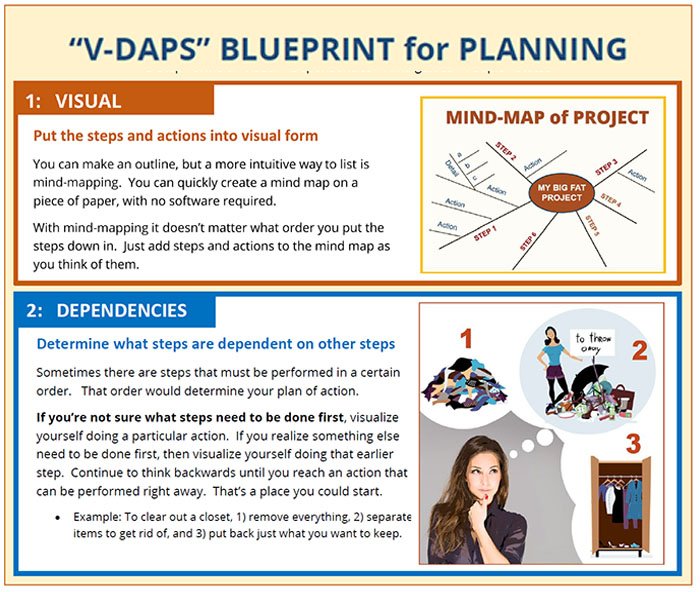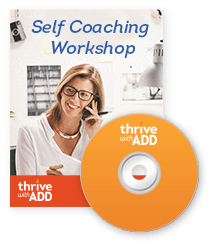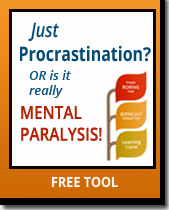
ADD-friendly planning for the overwhelmed
Does the word “planning” make you shudder, or feel instantly inadequate? If so, you probably feel slammed with overwhelm pretty often.
That makes sense, because if you have a number of projects to do – and those projects have multiple steps to perform – you’d need to be able to create a realistic plan for getting all of those steps done.
And when those projects have deadlines and you’re not sure where to start, that’s a deer-in-the-headlights moment!
5 Steps to Start Your Project Plan
Here’s a 5-step mini-blueprint for planning that I call “The V-DAPS Formula.” It stands for Visual, Dependencies, Ambiguities, People & Status.
STEP 1: VISUAL
Put the steps and actions into visual form.
Although you could just write or type out the steps of your project, I recommend mind-mapping. You can quickly create a mind map on a piece of paper, with no software required. Mind-mapping is particularly ADD-friendly because doesn’t matter what order you put the steps down in. Just add actions to the mind map as you think of them.
- Google “how to mind-map on paper” and you’ll find lots of free instruction and quick YouTube videos to show you how. If the project is very complex, however, mind-mapping software could make it easier to get it onto a page. It’s free and it’s easy to learn.
STEP 2: DEPENDENCIES
Determine any dependencies – steps that must be done in a particular sequence.
Some actions depend on other steps having been performed first. For instance, in home repair where you’re spiffing up an interior wall, steps must be performed in a certain order. You would need to first spackle any holes, then smooth the rough spots, then prime the wall… and finally paint it. The prescribed order of those steps would determine your plan.
- If you’re not sure what steps need to be done first, visualize yourself doing a specific action. Is it possible to dive right into it, or would something else need to be done first? Then visualize yourself doing that earlier step and ask yourself the same question. Continue to work backwards until you reach an action that can be performed right away. That’s a place you could start.
At this point, you know all the steps that have to be done, and which ones must be done early because subsequent actions depend on them. For steps that don’t involve dependencies, it may not matter what order you do them in.
Now review your entire list or mind map and see if anything on it involves unknown factors or other people.
STEP 3: AMBIGUITIES
Identify and list any ambiguities where something is unclear, unknown or you have questions
Make an Ambiguity List of any areas that seem unclear, where you need questions answered, or are unsure about how to perform that step. You’ll want to get answers quickly because what you learn may influence actions of the project.
Create your Ambiguity List divided into 2 columns based on the way you’ll seek answers:
- Conduct research – in online search, database or written materials
- Ask a person
Don’t let ambiguity be paralyzing; get uncertainties and questions cleared up as soon as possible!
STEP 4: PEOPLE
List any steps that will require the assistance or cooperation from another person.
If you need to involve others, you’ll want to secure their cooperation and availability from the beginning. Even if you won’t need someone’s involvement until a later stage, give them a “heads up” about it early to make sure they’ll be around. You would hate to find out that a necessary person is on vacation at the time you need their input.
If you also have questions for a particular individual, you can ask your questions and advise them of future involvement in the same email, call or meeting.
There’s one more early step to get started on a complex project that will make any planning much easier:
STEP 5: STATUS
Create a simple Status Report
Starting a complex project with a visual report form will make any planning much easier. This report might only be seen by you, but it can help you stay grounded on the status of each step of the project. This is especially important if you may get interrupted mid-project and not get back to it right away… or if there’s any stage where you’ll have to wait for something to happen or for someone else to do their part. It's all too easy to forget about something pending and not notice if someone is late getting back to you.
- Your columns could be headed: Action Step, Who is Responsible, Targeted Completion Date, Status of Action Taken and Comments.
A Status Report template can be created in Excel, in Word, or simply drawn on paper. The key to it working for you is making sure you update it regularly as each step is started and completed.
The V-DAPS Blueprint for Planning is a quick-reference guide to the first steps of planning. (Click here to download.)
Those “V-DAPS” steps will get you started on a plan. Of course, to feel ultra-confident at planning, you'll want to know that you can plan somewhat realistically.
How to plan realistically
Lay out one calendar or planner where you can see ALL your commitments for the week, the month or more. Make sure you block out time for getting places, meetings, and the usual kind of interruptions of work and life. That will give you an idea of the available time you have to work with.
Then slot out time on the calendar to work through your your V-DAPS planning steps.
Did you get them done in the time you imagined? If not, modify your future time projections accordingly and pay attention to how much you're “off.” By paying conscious attention and using your observations on how long steps take compared to your estimates, your time sense will get better as you go.
Learn planning skills at a comfortable pace
PRODUCTIVITY PATHFINDER:
A step-by-step system for ADHD self mastery
What has been the hardest aspect of planning for you?
Please comment and share!






Bonnie
The hardest part of planning is knowing how to organize the steps to get to your goal. What should be the first step when there are so many to choose from?
Bonnie Mincu
Try the visualizing technique to figure out where to start. If you imagine yourself starting with a certain step but realize something else must be done first, keep working backwards in the visualizing until you imagine yourself doing a step with nothing else needed first. That’s a place to start. But a lot of the time, it may not matter what you start with… so start with the easiest!
Christina
The hardest part of planning for me is focusing and having a realistic sense of all the components involved . I find myself bogged down in details that add extra time to my projects while I am executing them . This leads to stress and sometimes overwhelm .
Bonnie Mincu
Christina, you have an advantage in that you can realize those details. The problem comes from not thinking them through before you start the project. You need STEP 1 (Visualize) in the planning formula. Mind-mapping would really help you nail down those details so they don’t trip you up in the middle of execution. Laying out all the details visually could also help you “edit” them down if necessary and decide if you really need all those fine points of execution.
Rum Tan
Yes, this is a big problem among ADHD students that they don’t know how to plan. I really like the way to have shared about ADHD students problem and tips to resolve them. There are many ways teachers can help students with ADHD learn, such as special needs tuition. Moreover, there are many personalized learning techniques that can also be used to help ADHD students in studies.